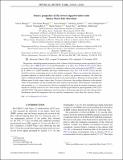Source properties of the lowest signal-to-noise-ratio binary black hole detections
Author(s)
Huang, Yiwen; Haster, Carl-Johan; Roulet, Javier; Vitale, Salvatore; Zimmerman, Aaron; Venumadhav, Tejaswi; Zackay, Barak; Dai, Liang; Zaldarriaga, Matias; ... Show more Show less
DownloadPublished version (1.798Mb)
Publisher Policy
Publisher Policy
Article is made available in accordance with the publisher's policy and may be subject to US copyright law. Please refer to the publisher's site for terms of use.
Terms of use
Metadata
Show full item recordAbstract
© 2020 American Physical Society. We perform a detailed parameter estimation study of binary black hole merger events reported by Zackay et al. [Phys. Rev. D 100, 023007 (2019)PRVDAQ2470-001010.1103/PhysRevD.100.023007] and Venumadhav et al. [Phys. Rev. D 101, 083030 (2020)PRVDAQ2470-001010.1103/PhysRevD.101.083030]. These are some of the faintest signals reported so far, and hence, relative to the loud events in the GWTC-1 catalog [B. P. Abbott et al. (LIGO Scientific and Virgo Collaborations), Phys. Rev. X 9, 031040 (2019)PRXHAE2160-330810.1103/PhysRevX.9.031040], the data should have lesser constraining power on their intrinsic parameters. Hence we examine the robustness of parameter inference to choices made in the analysis, as well as any potential systematics. We check the impact of different methods of estimating the noise power spectral density, different waveform models, and different priors for the compact object spins. For most of the events, the resulting differences in the inferred values of the parameters are much smaller than their statistical uncertainties. The estimation of the effective spin parameter χeff, i.e., the projection of the mass-weighted total spin along the angular momentum, can be sensitive to analysis choices for two of the sources with the largest effective spin magnitudes, GW151216 and GW170403. The primary differences arise from using a 3D isotropic spin prior: the tails of the posterior distributions should be interpreted with care and due consideration of the other data analysis choices.
Date issued
2020Department
LIGO (Observatory : Massachusetts Institute of Technology); Massachusetts Institute of Technology. Department of Physics; MIT Kavli Institute for Astrophysics and Space ResearchJournal
Physical Review D
Publisher
American Physical Society (APS)
Citation
Huang, Yiwen, Haster, Carl-Johan, Roulet, Javier, Vitale, Salvatore, Zimmerman, Aaron et al. 2020. "Source properties of the lowest signal-to-noise-ratio binary black hole detections." Physical Review D, 102 (10).
Version: Final published version